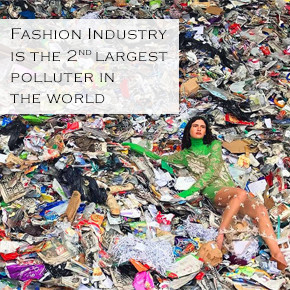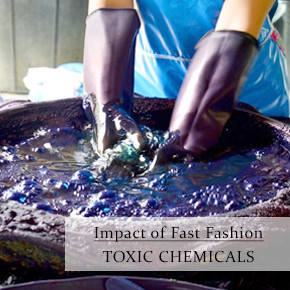Social & Economic Environment of Fashion
Fashion Industry is one of the oldest and largest industrial sectors in the world. The production of clothes has almost doubled in the last 15 years which is driven by the middle class population across the world. The constant reduction in the manufacturing cost has brought down the price of the garments. This has resulted in serious consequences on the health of textile workers and our planet. Nowadays our clothes get faded and shapeless very soon as the quality of garment is declining every year. People continue to often purchase as the trend keeps on changing at a very rapid pace. The fashion supply chain is complex having 4 different levels, the process of which includes design, raw material harvesting, yarn production, dyeing, weaving, stitching and garment construction. Currently fashion keep on changing at a very rapid pace and hence apparels have a very short product life cycle.
The Fashion Industry has adverse impact on the environment and society. Fashion Industry is the second largest polluter in the world just behind the Oil Industry. However, there are few alternatives and solutions to reduce these issues. The first and the major step lies in providing awareness to make necessary changes.What is Fast Fashion?
First of all, have you ever thought of "How many times do we wear a particular garment before we throw them out?" Fast Fashion is also known as Disposable Fashion, which can be defined as trendy, stylish, cheap, mass-produced garments to meet customer requirements with respect to the latest trends in the market. In other words, it can be described as clothing that moves quickly from the fashion ramps to the retail outlets to fulfill consumers trendy needs. To make these clothes affordable they are not built to last long as they quickly go out of style. The assumption of fast fashion is that consumers want high fashion at a very low cost. The launch of new trends makes us feel constantly outdated and encourages us to keep on purchasing new clothes often. Fast fashion garments have a very short product life cycle. Fast fashion brands introduce new styles at more frequent intervals, focusing less on durability, and more on low cost & the latest designs.Environmental Impacts of Fast Fashion
Fast fashion has a huge impact on our planet. Although consumers enjoy having stylish and inexpensive garments, fast fashion has been criticized for its ethical and environmental impact. Approximately every second, one garbage truck of clothes is either dumped into empty lands or burnt.
- Water PollutionTextile and Garment Industry produce nearly 20% of global waste water. In most of the countries where garment manufacturing take place, untreated toxic waste water from the garment factories directly flows into the nearby rivers. The waste water from these factories contains mercury, lead and many other toxic substances which are extremely harmful for the aquatic life. The fertilizers used during cotton production contaminates the water. It also effects the health of people who live nearby those river banks. The contaminated water from the rivers reaches the sea which eventually spreads all over the globe. Synthetic garments such as nylon and polyester release micro fibres in water during each wash. This water then makes its way to the oceans which is then consumed by small fishes. This introduces plastic to our food chain.
 Ways to reduce Water Pollution:
Ways to reduce Water Pollution:- Opt clothes that are manufactured in countries like Canada, Europe and USA which have strict environmental regulations.
- Select fabrics that do not require chemicals for production. For example: Natural & Organic Fabrics.
- Usage of Toxic ChemicalsMaking fibres, dyeing fabrics, bleaching etc are the major part of the textile production which uses chemicals. Clothes still contain a lot of chemical even when they arrive at the local retail outlets. Human skin absorbs anything that comes in contact with it, that includes the chemicals in the clothes we wear. This can cause a real danger to our health. The usage of heavy chemicals in cotton farming is one of the major reasons causing diseases and premature death among cotton cultivators.
 Ways to escape from Toxic Chemicals
Ways to escape from Toxic Chemicals- Remember to wash new clothes before you wear them for the first time.
- Purchase clothes with chemical content certification label such as BLUESIGN, GOTS or OEKO-TEX.
Bluesign, a Switzerland based organization, officially known as Bluesign Technologies AG is an emerging standard for environmental health and safety in textile manufacturing. They examine energy inputs, manufacturing processes of raw materials, air & water emission outputs etc...
- Water ConsumptionFashion Industry is the world's second largest consumer of global water supply and thus Fashion is known as a Thirsty Business. Cotton is one of the most important natural fibers in the textile industry which is usually cultivated in warm & dry areas. The production of cotton requires a lot of water. It requires around 20,000 litres of water to produce 1 KG of cotton. Huge quantity of fresh water is used for dyeing, finishing process, washing of fabrics like polyester, viscose, cotton etc... It requires around 2,700 litres of water to produce one cotton shirt and 3,500 litres for a pair of jeans. This quantity of water is enough for a person's drinking needs for around 2.5 years.
 Solutions to Save Water
Solutions to Save Water- Use fabrics such as linen which requires less quantity of water for its production.
- Accumulation of Garment WasteAs clothing has become disposable we generate more textile waste. Most of the clothes that we wear contains polyester, elastic or Lycra. These cheap fibers are becoming the garment industry's miracle solution. But production of these, creates pollution, and they are hard to recycle. Synthetic fibres are used in most of our clothing which are non biodegradable. Synthetic fibres like polyester can take up to 100 years to decompose whereas nylon takes 30-40 years.
 Solutions
Solutions- Purchase better quality clothes which will last long
- Emission of GasesThe production, manufacturing and transportation of millions of garments leads in generating a lot of greenhouse gases. Synthetic fibers like nylon, polyester and acrylic are made from fossil fuel. Coal is used as the main power source in most of the countries like China, India and Bangladesh were majority of the clothes are produced. This is the polluted type of energy in terms of carbon emission. Every year, the UK clothing industry is responsible for the release over 3 million tonnes of CO2. The level of emissions depends on the type of fabric and the processing techniques involved. The consumption of non-renewable resources (petrochemicals) is required to produce two very common synthetics used in the apparel industry, polyester and nylon.
 Solutions
Solutions- Buy clothes made in countries powered by more renewable energy.
- Degradation of SoilSoil is one of the essential elements of our ecosystem. We require healthy soil for the cultivation of our food. The extensive degradation of soil happening globally is one of the current environmental issues. Textile and Garment Industry play a major role in soil degradation in many ways.
- Deforestation caused to produce wood based fibres like Rayon
- Degradation of soil due to excessive use of toxic chemicals
 Solutions
Solutions- Choose eco-friendly fabrics
- DeforestationOver 50 million trees are cut down every year for the production of our clothes. Around 5% of the global apparel industry uses forest based fabrics. To make wood-based fabrics like viscose and rayon, large scale deforestation has been done.

Social Impacts of Fast Fashion
Clothing industry has helped many countries in developing their economy but it also comes with a lot of social challenges. Few globally faced impacts of fast fashion are- In the apparel industry, around 80% of the workers are young women within the age group of 18 -24 years.
- The pay scale for the workers at the apparel industry is way below the normal range to live a decent life with basic facilities.
- Child labor is very common as garment industry needs low-skilled labor. In countries like Bangladesh, China, Philippines, Brazil and India evidences of child labour are still found.
- In countries like Uzbekistan forced labor have been reported where children are taken out of schools to harvest cotton.
- Industries are also held responsible for the poor working conditions of employees at the manufacturing units. Industries in developing countries can have less stringent restrictions through regulations than those in the developed nations. With poor working conditions, workers suffer from health hazards like backache, miscarriage, acidity, varicose vein, asthma, burns and other injuries. In few countries, workers even suffer from severe kidney issues as they are only provided with restricted toilet breaks.
What can we do?
In 2009, Jennifer Hyman and Jennifer Fleiss launched a company named Rent the Runway which provides designer dress and accessories on rental basis. Christine Hunsicker launched another similar company named "Gwynnie Bee Inc" in 2011, which provided unlimited styles for women on a rental subscription basis. Their tag line "Raid our closet as often as you like - anytime, anywhere - and never wear the same outfit twice!" had become very popular.- Try to donate clothes that are wearable
- Choose clothes that are free from chemicals (Organic cotton)
- Avoid washing clothes frequently
- Try not to purchase clothes that require dry cleaning
- Purchase right quality garments which last long
- Take the 30-wear promise
Have you heard of 30-wear promise?
Before your next purchase, ask yourself: Will I wear it a minimum of 30 times?. Celebrities like Livia Firth & Emma Watson have endorsed the 30-wear promise. #30wearschallenge is one way for regular people to contribute towards something positive and embrace a more sustainable fashion industry. It is all about wearing every piece of garment, minimum 30 times before you dispose it.- To produce 1 KG of textile, around 1 KG of chemicals are required.
- Among the chemicals used to make clothes, 11 are dangerous.
- Over 20% of industrial water pollution comes from dyeing and textile treatment.
- In the last 20 years, we have produced 400% more garments.
- Most women only use 20 - 30% of clothes in the closets.
- Around 150 billion garments are produced per year.
| Published On | - | 2021-03-16 |
| Modified On | - | 2021-03-16 |
| Author | - | Team WIFD |
| Publisher | - | Waves Fashion Institute |
| https://wifd.in//social_and_environmental_impact_of_fashion | ||





Dive into the festive fervor as Soha Ali Khan and her daughter Inaaya twin in matching traditional attire, spreading joy & style this Eid.

Iswarya Menon stuns in a sky blue sheer half-saree adorned with sequins, setting the stage for a mesmerizing fashion tale.
Discover the timeless wisdom & style insights from 15 iconic fashion designers. Explore their memorable quotes & be inspired to embrace fashion with flair.

Shanaya Kapoor dazzles in a pearl embellished saree at Anant Ambani and Radhika Merchant's wedding, bringing ethnic wear to a whole new level.






